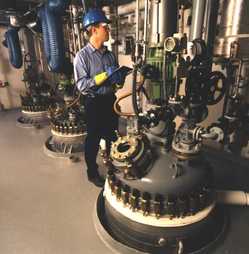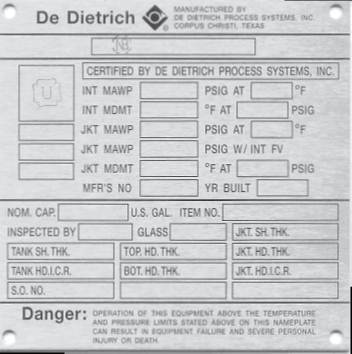Inspection Checkpoints for Vessel Start-Up [Part 1]
 Whether you’ve just had a brand-new vessel installed in your plant or you are bringing an existing vessel back into production after some downtime (due to cleaning, maintenance, or other service-related procedure) it’s critical to make sure your i’s are dotted and t’s are crossed before you start-up your vessel. But what are those i’s and t’s? Knowing this information can mean the difference between an easy, smooth start-up and some potentially serious (and completely preventable) issues.
Whether you’ve just had a brand-new vessel installed in your plant or you are bringing an existing vessel back into production after some downtime (due to cleaning, maintenance, or other service-related procedure) it’s critical to make sure your i’s are dotted and t’s are crossed before you start-up your vessel. But what are those i’s and t’s? Knowing this information can mean the difference between an easy, smooth start-up and some potentially serious (and completely preventable) issues.
We’ve compiled a Vessel Start-Up Checklist, free for you to download and use. By creating a formalized procedure that you can refer to each time you start-up your vessel, you are not only ensuring your equipment will run safely, but you are maintaining a safe work environment for your employees.
In the first part of this two-part post, we’ve outlined some of the questions and action steps you need to address as you prepare your vessel for start-up and why each step is important.
General:
Is the nameplate uncovered and all stampings clearly visible?
Your vessel’s nameplate is like its identification card and contains the following information:
- Manufacturers Identification Number (Serial Number)
- National Board Registration Number
- Vessel Design Pressure
- Vessel Design Temperature Range
- Vessel Capacity
- Year Vessel Fabricated
- Type of Glass Lining

As a best practice, we recommend that you copy this information and store it with other important data about the vessel in the event that the nameplate gets lost or damaged.
Are sight glasses free of any scratches, chips and/or cracks?
Damage to the sight glass can be compounded when the vessel is pressurized, and you don’t want to run the risk of contaminating your product. Although rare, sight glasses can incur damage during transportation if the equipment is mishandled, so a quick visual inspection to ensure it’s intact is an easy but necessary task.
Is the internal cross-bracing removed?
New vessels are usually shipped with the agitator/drive system and baffles installed. Diagonal support structures help to protect these components from moving around during transportation as well as to keep the internal glass lining safe. All cross-bracing should be removed as soon the vessel has been installed into its final destination and prior to installation of additional components and before running the agitator.
Mixing Components:
Is the agitator runout less than 0.010” just above the shaft seal housing?
On any type of rotating machinery, you should occasionally check for any deviation in the shaft rotation. Any stray from the centerline is known as runout. DDPS allows for a deviation of up to 0.010” – anything greater than suggests the agitator was not installed correctly and needs to be adjusted.
Does the agitator turn clockwise or counterclockwise?
DDPS agitator blades are designed to be used in either direction. Make sure they run in the correct direction for your process, so they produce the anticipated mixing effect. Running the agitator the wrong way can not only affect your reaction, but possibly compromise your entire process if operated incorrectly. This is especially true in the case of GlasLock blades, which are installed at specific angles to help achieve your optimal mixing results.
Have the vessel and accessories been spark tested?
As part of our Quality Control measures, new vessels and other glass-lined components are spark tested prior to shipment. We recommend that you perform follow-up inspections on an annual basis for agitated vessels and once every 1-2 years for non-agitated vessels (Note: this is an estimated time period and can fluctuate based on your process specifications as well as other factors). The type of spark testers that you use will depend on if the equipment is grounded. For more information on spark testing consult our Glass-Lined Equipment Inspection eGuide.
Is the baffle straight and in line with the agitator?
The positioning of the baffle in relation to the agitator is crucial to accomplish effective mixing. It’s important to check that your baffle is installed correctly and situated on the right nozzle so that the two components work cohesively.
Drive System:
Ask yourself the following yes/no questions when you are inspecting your drive system prior to start-up. Actions should be taken to fix any leaks or other issues that present themselves during inspection of this component:
-
Are there any oil leaks at the agitator or gear drive seals?
-
Is the gear drive oil level at the correct level on the dip stick?
-
Is the gear drive free of any excessive noise or temperature?
-
Does the drive have the recommended lubrication?
-
Is the nitrogen connected to the seal housing with a positive pressure differential?
Nozzles:
Are the nozzle loadings within allowable limits?
There are limitations to the net forces that nozzles can be subjected to. Make sure all connected equipment and piping are aligned properly, keeping in mind that you need to account for thermal expansion where applicable.
Do the inlet nozzles have dip pipes or nozzle liners?
Dip pipes are often installed on an inlet nozzle for baffling, sampling, and/or temperature measurement. PTFE nozzle liners are typically used to protect the nozzles of glass-lined vessels from corrosive materials.
Are the agitating nozzles positioned properly?
When your vessel was manufactured, the site of the agitating nozzles on the vessel was selected to enhance the turbulence objective. Confirm that the nozzles are located where they should be to ensure process optimization.
Agitating nozzles are installed in the vessel jacket inlets to promote the flow of the jacket media used. Make sure they are all going in the same direction.
Stay tuned for next week’s post, where we’ll discuss the other items that need to be inspected prior to starting-up your vessel. Or, for a sneak peek, download a copy of our Vessel Start-up Checklist.
